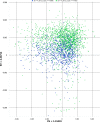Association and interaction of myopia with SNP markers rs13382811 and rs6469937 at ZFHX1B and SNTB1 in Han Chinese and European populations
- PMID: 28848321
- PMCID: PMC5561140
Association and interaction of myopia with SNP markers rs13382811 and rs6469937 at ZFHX1B and SNTB1 in Han Chinese and European populations
Abstract
Purpose: Previously, a genome-wide association study (GWAS) identified rs13382811 (near ZFHX1B) and rs6469937 (near SNTB1) to be associated with high myopia. The present study evaluates the association of these two single nucleotide polymorphisms (SNPs) with moderate to high myopia in two Chinese cohorts and two cohorts of European populations.
Methods: Two Chinese university student cohorts, including one with 300 unrelated subjects with high myopia and 308 emmetropic controls from Guangzhou and a second with 96 unrelated individuals with moderate to high myopia and 96 emmetropic controls of Chaoshanese origin in Guangzhou, were enrolled in this study. Two SNPs, rs6469937 and rs13382811, were selected for genotyping based on their reported associations with severe myopia. The SNPs were genotyped via DNA sequencing. In addition, association analysis of both SNPs was performed using genotype data from the database of Genotypes and Phenotypes (dbGaP) involving a total of 2,423 samples in two independent cohorts of European-derived populations, as follows: Kooperative Gesundheitsforschung in der Region Augsburg (KORA) and TwinsUK. The allelic and genotypic distribution among cases and controls were analyzed using the Chi-square test. Logistic regression was used to evaluate the SNP-SNP interaction. Fisher's exact test was used for two-SNP comparisons.
Results: In the Guangzhou cohort, SNP rs13382811 near ZFHX1B showed significant association with high myopia (pallelic = 0.0001, pgenotypic = 4.07 × 10-5), with the minor T allele showing an increased risk of high myopia (odds ratio [OR] = 1.68, 95% confidence interval [CI] = 1.28-2.20). SNP rs6469937 near SNTB1 showed nominal evidence of association (pallelic = 0.0085, pgenotypic = 0.0166), which did not withstand correction for multiple testing. No significant association was detected in the smaller Chaoshan cohort alone. The association of SNPs rs13382811 and rs6469937 remained significant when both Han Chinese cohorts were combined (pallelic = 0.0033 and 0.0016, respectively), and it was also significant under the genotypic test (pgenotypic = 0.0036 and 0.0053, respectively). When both SNPs were considered together under a recessive model, their significance increased (p = 8.37 × 10-4), as did their effect (OR = 4.09, 95%CI = 1.7-9.8). The association between either of these two SNPs alone and myopia did not replicate significantly in the combined cohorts of European descent, providing only suggestive results (pallelic = 0.0088 for rs13382811 and pallelic = 0.0319 for rs6469937). However, the effects of the combined SNPs showed significant association (p = 8.2 × 10-4; OR = 1.56, 95%CI = 1.2-2.0). While the risk for myopia increased with risk alleles from both SNPs, the increase was additive rather representing a multiplicative interaction in both populations.
Conclusions: Our study confirms that the two susceptibility loci ZFHX1B and SNTB1 are associated with moderate to high myopia in a Han Chinese population, as well as in a European population, when both SNPs are combined. These results confirm previous reports of their associations, extend these observations to a European population, and suggest that additional interactive and possibly population-specific genetic or environmental factors may affect their contribution to myopia.
Figures




References
-
- Schwartz M, Haim M, Skarsholm D. X-linked myopia: Bornholm eye disease. Linkage to DNA markers on the distal part of Xq. Clin Genet. 1990;38:281–6. - PubMed
-
- Paluru P, Ronan SM, Heon E, Devoto M, Wildenberg SC, Scavello G, Holleschau A, Makitie O, Cole WG, King RA, Young TL. New locus for autosomal dominant high myopia maps to the long arm of chromosome 17. Invest Ophthalmol Vis Sci. 2003;44:1830–6. - PubMed
MeSH terms
Substances
LinkOut - more resources
Full Text Sources
Other Literature Sources
Research Materials

